10 Best Rifle Scopes Under $600 in 2025 – Reviews & Top Picks
Last Updated on

For some reason, people tend to believe scopes that don’t cost an arm and a leg are second-rate optics, and those that require you to break the bank are top-grade. But that’s not true. As matter of fact, if you can just take a minute to learn about some of the features that make those so-called “top-grade scopes” that expensive, you’ll realize that they are all bells and whistles. Other than aesthetics, they contribute nothing of value.
For the record, we’re not saying pricey scopes are low-quality scopes. All we’re saying is, you can still find a great rifle scope that’s under $600 in 2021. And these are our top picks:

A Quick Comparison of Our Favorites
| Image | Product | Details | ||
|---|---|---|---|---|
| Best Overall |
 |
Simmons Matte Black Riflescope |
|
CHECK PRICE |
 |
Vortex Optics Crossfire II Riflescopes |
|
CHECK PRICE | |
 |
Bushnell Banner Dusk & Dawn Multi-X Reticle Riflescope |
|
CHECK PRICE | |
 |
UTG 3-12X44 30mm Compact Scope |
|
CHECK PRICE | |
 |
Pinty Illuminated Rifle Scope |
|
CHECK PRICE |
The 10 Best Rifle Scopes Under $600 – Reviews 2025
1. Simmons Matte Black Riflescope – Best Overall
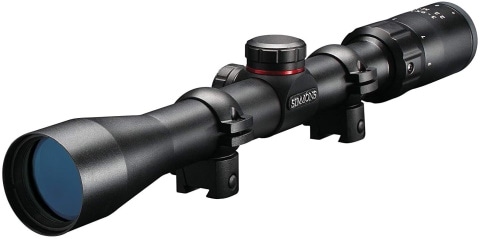
What makes the Simmons Matte Black Riflescope so special? A couple of things. But more importantly, the Truplex Reticle feature. This type of reticle is somewhat different from the traditional reticle, in the sense that it has both the finer aiming lines and heavy ones as well.
They’re heavier so as to help users find a target’s center faster, and finer to provide a precise aiming point.
The Matte Black scope is shockproof, fog proof, and waterproof. And it’s pretty obvious that Simmons invested a lot of time and money to guarantee such a performance. They know nobody wants to roll the dice on an optic that can’t even handle light showers or a few bumps.
The HydroShield coating technology applied on both sides of its lens is the reason why it’s so good at repelling fog and water. And it works in a very simple way. First off, it will absorb whatever moisture comes into contact with the lens. Once it gets to the saturation point, it will start to repel everything to the side, leaving a clear view for the guy looking to pull the trigger.
“What about the SureGrip rubber surfaces?”
Those are there to ensure that any user wearing gloves doesn’t experience any difficulty while making the necessary adjustments.
We again noticed that the scope could rectify our parallax problem. We weren’t totally convinced when Simmons tried to explain it to us, but after a couple of tries, we were sold. Its parallax correction has been preset from 50 yards to infinity.
The Quick Target Acquisition eyepiece feature was another impressive feature. We were able to acquire targets in a flash. Something that we rarely see in other scopes.
We honestly love everything about it—including the Rimfire ⅜-inch dovetail mounting rings—except for one thing. And that’s the turret clicks that weren’t as audible as we would like them to be.
- Truplex Reticle feature
- Matte Black finish
- HydroShield coating technology
- SureGrip rubber surfaces
- parallax correction preset from 50 yards to infinity
- Quick Target Acquisition eyepiece
- Rimfire ⅜” dovetail mounting rings
- Shockproof, fog proof, and waterproof
- Inaudible turret clicks
2. Vortex Optics Crossfire II Riflescopes

The Vortex Optics Crossfire II Riflescope is one of the few scopes that come with a maximum elevation adjustment of 60 MOA. It’s also part of the Crossfire II line model family, so you know you’re getting an optic that will deliver precision and accuracy.
For those who were asking, Vortex thought the Dead-hold BDC Reticle feature was a necessity. It’s supposed to quell the different issues surrounding the estimation of holdover, at varying ranges.
By the way, did you realize the MOA clicks could be reset to zero after sighting in? And that’s not even the only thing that got our attention. We were so impressed by how strong that housing was that we almost got two of them.
Well, impressed but not surprised, considering we’ve always known single-piece tubes are stronger than multi-piece tubes.
We think it’s time to put respect next to the brand’s name, seeing as they’ve given us solutions to almost every problem that we’ve encountered in the past. For example, when we asked whether the optic was shockproof, they told us it’s an aircraft-grade aluminum construction. We went ahead to inquire whether it could deliver an impressive fog proof and waterproof performance, and they told us it’s nitrogen purged and O-ring sealed.
By the time they were explaining how it’s ultra-forgiving eye box and long eye relief will guarantee users get to the target faster, we knew they’re obviously probing our minds using some alien device.
The only bummer was, the scope didn’t come with flip up covers. But we’ll forgive them. It was still worth every penny.
- Maximum elevation adjustment of 60 MOA
- Ultra-forgiving eye box
- Long eye relief
- Aircraft-grade aluminum construction
- Nitrogen purged and O-ring sealed
- MOA clicks could be reset to zero
- Dead-hold BDC Reticle feature
- Doesn’t have flip up covers
3. Bushnell Banner Dusk & Dawn Multi-X Reticle Riflescope

In the words of Bushnell, the Banner Dusk & Dawn Multi-X Reticle scope has been constructed using materials that were 100 percent top grade. Do we believe them? Yes. But that’s only because we’ve already extensively tested the device. It’s for sure a quality optic with a remarkable HD clarity.
The device is a second focal place optic, with multi-x crosshair reticle technology. That’s our way of telling you that it can deliver a classic sight picture, makes acquiring targets a lot easier, and enhances visibility at dusk or dawn. Hence, making it the perfect low-light tool for shooters/hunters working in low light conditions.
Focusing on any type of target with perfect clarity won’t feel like a hassle, since it has a fast-focus eyepiece that’s designed to help users quickly recalibrate the reticle to the eye. And to protect the resettable elevation and windage turrets against bumps, Bushnell decided to add a cap.
We also liked its sleek cutting-edge design, and how you could just tell this was something built to last. We don’t exactly know if that feeling was brought about by the fact that its lenses are fully multi coated, but we appreciate it nonetheless.
Speaking of durability, a lot of you probably don’t know this but the Banner Dusk & Dawn Multi-X Reticle scope has an IPX4 waterproof rating. That means it’s not waterproof, but water resistant. It can only protect itself from water splashes.
Please, DO NOT submerge it in water, or let it stay in a puddle for too long.
- Second focal place optic
- Remarkable HD clarity
- Enhances visibility at dusk or dawn
- Turret protection cap
- Resettable elevation and windage turrets
- Multi-x crosshair reticle technology
- IPX4 waterproof rating
- Fully multi coated lenses
- Sleek cutting-edge design
- Fast-focus eyepiece
- Not waterproof, but water resistant
4. UTG 3-12X44 30mm Compact Scope
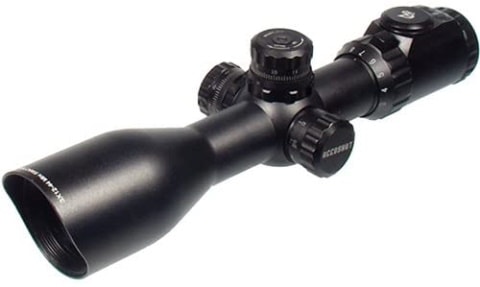
Now, compared to the other scopes that we’ve just reviewed, the UTG 3-12X44 30mm is really compact. And being compact, it’s safe to assume UTG didn’t have to invest a lot of resources in its production. Also, compact equates to portable, a word that rifle scope users love to hear.
The sighting device has a 36-color mil-dot reticle—The kind of feature that screams precision accuracy, visibility, and versatility, from a mile away.
And in case it hasn’t clicked yet, that ‘versatility’ part was meant to remind you that the scope is a variable powered device. It has an incredible range, as you can tell from the description above. If you can get your hand on it, you’ll have the option of working with a scope that will deliver at close-range and mid-range, and long-range.
This 30mm tube scope has always been grouped with the best scopes when it all boils down to devices that are capable of achieving effective light transmission for quality clarity. That’s mainly because it features multi emerald coated lenses.
And we wouldn’t sleep on that innovative EZ-TAP illumination Enhancing (IE) system feature, if we were you. It’s the type of technology that you’d wish your scope had, if you’re shooting/ hunting in harsh weather or low light condition.
The Side Wheel Adjustable Turret (SWAT) will take care of your parallax, and the special circuit will ensure its illumination isn’t interrupted in any way, shape or form, by heavy recoil.
Does it come with anything else? Yup. It comes with quality batteries and high-profile mounting rings.
Would we recommend this scope to anyone? Yes. Just don’t break the front lens cover because then you’ll have to scour the ends of earth to find a replacement.
- EZ-TAP illumination Enhancing (IE) system feature
- Side Wheel Adjustable Turret (SWAT
- Quality batteries
- High profile mounting rings
- 36 color mil-dot reticle
- Compact in nature
- 30mm tube scope
- Features multi emerald coated lenses
- A variable powered device
- Front lens replacement difficult to find
5. Pinty Illuminated Rifle Scope
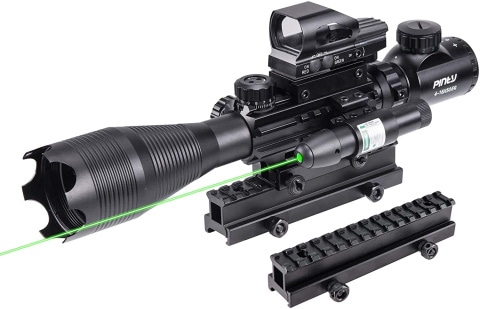
Truth be told, if we were to list all the Pinty Illuminated Rifle Scope features in this one article, we’ll camp here the whole night. So, we’ll just look at the main ones, starting with the 4-16x magnification. This feature is quite frankly the main reason why shooters feel the scope is best suited for a wide range of shooting.
And that’s not the only department that brings versatility to the table, as we’ve learned that the 14 slots riser mount is compatible with a weaver rail system scope, and one designed with a picatinny rail.
Pinty Illuminated Rifle Scope comes with a holographic dot sight. If you’ve been in this business long enough, you’ll know holo-sights are not like red dot sights. Instead of making you move your eyes back and forth between the target plane and optical plane, you’ll be able to focus on the reticle and target simultaneously. Meaning, it’s less affected by parallax distortion.
Now that we’ve mentioned the reticle feature, we should also add that it has 4 different reticle patterns. You’ll also have the option of switching between red and green illumination, and 2 separate buttons to adjust its 9-brightness levels.
The level of accuracy that it offers can be attributed to the detachable green laser, with independent switch. That thing can cover a distance of 110 yards, making it one of the most desired features on a scope.
It’s totally safe to use it while it’s raining, since it’s anti-fog and waterproof. And because the lenses have coatings, it will provide you with an unbeatable optical clarity.
The only issue was with the diopter adjustment on the eyepiece. We don’t like complaining but… It was ridiculously stiff.
- 4-16x magnification
- A holographic dot sight
- Red and green illumination
- It’s anti-fog and waterproof
- Detachable green laser, with independent switch
- Lenses have coatings
- 14 slots riser mount
- 9-brightness levels
- Eyepiece diopter adjustment stiffer than usual
6. Monstrum G3 6-24×50 FFP Rifle Scope

The Monstrum G3 6-24×50 FFP Rifle Scope is the type of optic that you’d typically go for, if you’re looking for something that can accurately clip a target that’s more than 1000 yards away. It’s an adjustable 6-24x power scope specifically designed for mid to long distance shooting users.
Shooters who prefer working with a first focal plane MOA reticle will also love this particular scope. The ranging information is very easy to read and interpret, and that’s how we know their ranging estimation and holdover correction will be quicker.
On the package, you’ll see the abbreviation AO. The ‘A’ is for adjustable, and the ‘O’ for an objective lens. Together, they’re telling you that the scope comes with an adjustable objective lens that supports a quicker range estimation by eliminating parallax, and allowing for a finer focus of the image.
The night owls, and their love to hunt under the cover of darkness, were also taken into consideration during the production process. And please don’t even try to convince us that those are not the users that Monstrum had in mind when it decided to incorporate the inline dial-controlled reticle illumination. The feature has multiple brightness intensities to enhance visibility in such environments.
What other goodies are found in the package? There’s one CR2032 3V battery, a detachable honeycomb filter sunshade (which is incredibly important), high profile/quality picatinny mounting rings, and… spring loaded flip-up lens covers.
Even though the reticle illumination feature is dope, it doesn’t work in all positions. Monstrum needs to rectify that problem before their loyal customers start shopping elsewhere.
- Inline dial-controlled reticle illumination
- CR2032 3V battery
- An adjustable 6-24x power scope
- Comes with additional accessories in the package
- An adjustable objective lens
- First focal plane MOA reticle
- Reticle illumination is kind of faulty
7. Burris Optics Fullfield E1 Riflescope
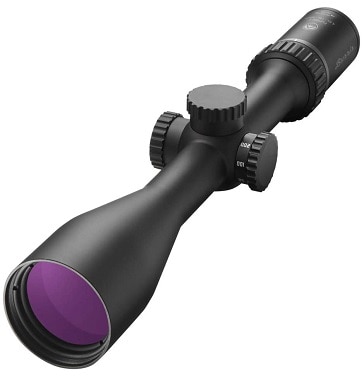
This one has a zooming power range of 4.5-14x, and that’s what makes it ideal for long-range shooting. We were also psyched up when we found out that its objective lens diameter is 42mm.
That’s to say, besides the improved image quality that you’ll be getting in low light conditions, you’ll also have the option of using the 14x magnification for a longer period of time, as light diminishes. Furthermore, finding that sweet spot will be a lot quicker thanks to its incredibly large exit pupil.
To ensure the scope has a fair shot in a long-range competition, Burris decided to settle for the Long Range MOA reticle feature. And it didn’t disappoint, as we were able to experience an ultra-fine precision that got us excited to try it out again next time.
Talking about the Optics Fullfield E1 scope without mentioning the cascading dots and trajectory-compensating technology that compensates for wind drift kind of feels wrong. It feels like downplaying the strides that Burris has made over the years.
The other feature that we’ve got to talk about is the Ergonomic Side Focus. It’s meant to help you adjust your parallax from 50 yards to infinity, and thus, minimize the margin of error.
Weirdly though, some Optics Fullfield E1 scopes don’t have this feature. And we don’t know why.
- Power range of 4.5-14x
- Ergonomic Side Focus feature
- Long Range MOA reticle feature
- Incredibly large exit pupil
- Cascading dots and trajectory-compensating technology
- Objective lens diameter is 42mm
- Some products lack the Ergonomic Side Focus feature
8. BARSKA Varmint Mil-Dot Riflescope
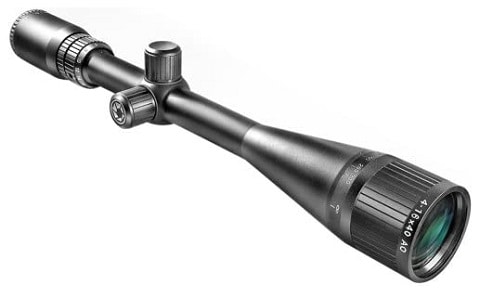
To better understand what this scope can do, we’ll have to answer questions that are often asked by different users. And the most common question is, “What’s the click value?”
Most scopes come with the standard ¼ MOA clicks, but the BARSKA Varmint Mil-Dot Riflescope’s click value gets measured in ⅛ MOA. Therefore, the Varmint Mil-Dot scope has twice as many clicks per knob turn.
“What’s the reticle like?”
It’s a 30/30 duplex reticle, which happens to be the most common style reticle in the market. It’s user-friendly and usually considered the all-purpose reticle.
You know, before trying out this scope, we did some research. And we learned that so many users were hypnotized by its long-range magnification power and 50mm adjustable objective lens. Typically, these are the features that define a good scope. If they can work as a unit, they’ll make the target image appear crisp, bright, and very close.
“Are the windage and elevation turrets easy to rotate?”
Yes, they are. And, to make sure that you don’t have a hard time making adjustments, they decided to make the numbered references appear cooler and clearer.
The BARSKA Varmint Mil-Dot Riflescope is fog proof, waterproof, but we don’t know about the shockproof part. The company says it’s shock proof, but… its performance was underwhelming. If the recoil is heavy, you might end up losing your zero.
- 1/8 MOA value per click
- 30/30 duplex reticle
- 50mm adjustable objective lens
- Easy to adjust windage and elevation turrets
- Fog proof and waterproof
- Not as shockproof as advertised
9. TRUGLO TRU-BRITE Illuminated-Reticle Rifle Scope
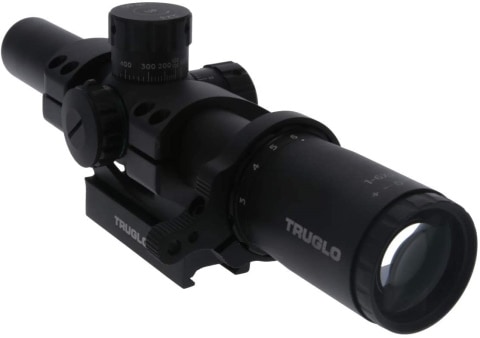
The TRU-BRITE Illuminated-Reticle Scope is a good scope, but falls short in a few areas. Some of the things that convinced us to purchase it include the extremely wide field of view, the .223 (55 grain) and .308 (168) pre-calibrated BDC turrets that can effectively engage targets that are more than 800 yards away, and the fact that it’s a 30mm tube meant to increase the brightness level.
We can also confirm that it’s a durable scope—since it’s CNC machined from aircraft-grade aluminum—and can easily outperform most sighting devices in the clarity and contrast scoreboard.
Now that that’s out of the way, let’s talk about the things that we didn’t really like. And first on our list is the leaf-spring click adjustments, meant to take care of the elevation and windage. Its knob is stiff. Probably stiffer than a marble statue.
We were promised the scope was waterproof but… No, it’s not. Or maybe they meant to tell us it’s water-resistant because it did resist up to a certain level, before throwing in the towel. And the only way those fully coated lenses will realize their full potential is if TRUGLO increases the objective lens’ diameter.
And that’s not all. The eye relief was almost zero, the mount didn’t fit on the picatinny rail, the battery drained so fast, and the scope couldn’t hold zero. So even though it made it to our top ten list, we are still very disappointed.
- .223(55 grain and .308(168)) pre-calibrated BDC turrets
- Extremely wide field of view
- CNC machined from aircraft-grade aluminum
- It’s a 30mm tube
- Not waterproof
- Battery juiced out fast
- Small objective lens
- Eye relief almost zero
- Mounting was a hassle and didn’t fit
- Can’t hold zero
10. Athlon Optics Argos BTR Riflescope

Just because Athlon Optics Argos BTR Riflescope is last on this list doesn’t mean that it’s the worst scope in the market. Compared to several other scope, it still held its own.
Firstly, you’ll be working with an advanced fully multi-coated optic lens that is very effective at transmitting light with the intention of bringing optimum brightness. They thought they should etch the reticle on the glass so as to sprinkle some element of complexity to the design, and we agreed.
The 6061T6 aircraft grade aluminum tube wasn’t a letdown either. It’s because of it that the device comes off as one of superior mechanical integrity.
What made us throw it to the last spot?
One, the fact that it isn’t as waterproof as advertised. Secondly, the illuminated reticles aren’t that useful during the day. We could also tell it was somehow affected by the changes in temperature. Hence, showing signs of thermal instability.
Thirdly, it’s shock resistance to recoil is still questionable, and it didn’t take us long to realize that it lacked the native zero-stop functionality. Lastly, if we were to describe the turret feature, we would say they’re middling between mushy and crisp.
- An advanced fully multi coated optic lenses
- Etched reticle
- 6061T6 aircraft grade aluminum
- Not waterproof
- Illuminated reticles aren’t visible during daytime
- Reticle is affected by changes in temperature
- Not shockproof
- Lack native zero-stop functionality
- Mushy turrets

Buyer’s Guide
In this section, you get to learn about the features that define a good scope. And you still have to pay attention because it’s just as important as the reviews section of this piece. That being said, the first scope feature that we would like to talk about is the…
Magnification
The ‘where’ and the ‘what’ will determine the type of rifle scope magnification that you’ll be going for. Where will you be hunting or shooting, and What will be the target. At the turn of the century, we mostly settled for the 3-9x scope or the fixed 4x. That was before, hunters started being ambitious. They felt like they needed something that could clip targets that are farther than 100 yards. And that’s how brands started manufacturing all-round scopes with even higher magnifications.
So, to answer the question of what’s the best scope magnification, we’ll say it’s one that’s able to produce clear images for targets under 100 yards, and those that are farther away.
Objective Lens
While we’re still on the topic of images, we should also talk about the objective lens—the feature mostly responsible for light transmission.
Things are not all that complicated here. All you need to know is, you need an objective lens that’s relatively large, and fully multi coated Large enough to perform well in a low light condition, but not too large to upset the balance of the scope. The coatings will take care of the reflection issues, UV light, and inadvertent scratches.
The objective lens’ diameter will be the number behind the ‘x’ that represents the magnification. For example, if the scope is described as a 4-12×44 optic, the 44 is your objective lens, and it’s measured in millimeters.
The objective lens size in the industry ranges from 20mm to 72mm. You should go for the one that’s 44mm in diameter. 20mm is too small to transmit sufficient light, and 72 is just laughable.
The Construction
When it comes to construction, you want to get a single-piece tube made of aircraft-grade aluminum. That’s the only way you’ll be certain it can effectively absorb shock from heavy recoil, and still feel light as a feather once mounted on the rifle.
Also, it should be argon or nitrogen purged, and completely sealed. We’re trying to avoid a situation where we’ve got to go back to the equipment store after an outing or two, just because the rain showers and fog compromised the optic’s system.
Parallax

The parallax won’t bug you if you’re working with a low power scope. But if the optic is high powered, you’ll definitely have to look for one with a parallax adjustment feature.
In case you’ve never heard of parallax, it’s the optical illusion that users often experience after increasing a scope’s magnification. If that margin of error isn’t rectified, it will be very difficult to hit any target at a distance that’s over 100 yards.
Reticles
Every rifle scope has a field of view. And in that field of view, you’ll find an aiming point, also known as the reticle. Now, this feature comes in different types. We have the basic/simple reticle, bullet drop compensating (BDC) reticle, MilDot/Rangefinding reticle, and the illuminated reticle.
Basic/ Simple Reticle
They are basic in that they only offer what’s important, and that’s the aiming point. But brands don’t really like calling them basic because…. Well, maybe it’s because it doesn’t have a nice ring to it. So, you’ll find them referring to them as the Heavy Duplex reticle, fine crosshairs, German, Circle reticle, or simply, the Plex.
A basic reticle will either be thicker or thinner. The thicker ones are mostly preferred by hunters who love hunting at dawn—or when the sky dusks—since they’re very visible against busy backgrounds and in low light.
Does that mean the fine crosshairs/thinner reticles are the least preferred? No. They’re also very common, but mostly preferred by those who go for extra precision. With the fine crosshair reticle, you’ll have the option of adjusting your shots in minute increments, owing to the fact that they have minimum subtension.
Illuminated Reticles

If you’ve noticed your scope’s reticle lights up, it’s an illuminated reticle. The main purpose of that light is to ensure your crosshairs are visible against busy backgrounds like foliage, or in situations where the lighting is inadequate.
But there’s a downside. Say, the scope that you’re using is the ‘cheap’ kind. And by ‘cheap’ we don’t mean less costly, but low-quality. If that’s the case, controlling its level of intensity will be problematic. The light produced will be too much for your eyes to handle, so you won’t be able to even see the target.
How did top brands solve this problem? They did so by adding the Minutely Adjustable Digital Control feature. Just go try one and tell us what you think.
Mildot/Rangefinding Reticle
From that description, you can definitely tell they’re efficient in estimating distance. And just so we’re on the same page, the ‘Mil’ in MilDot doesn’t stand for military. It’s the short form of milliradian, which is one-thousandth of a radian.
What’s a radian? In simpler words, a radian is an angular unit of measurement, based on a circle’s radius. If you take the length of a radius and wrap it around its respective circle, the arc shape will form an angle at the circle’s center. Measure that angle, and you’ll realize it’s equal to 1 radian.
Anyway, at 100 yards, that reticle’s mil will subtend 3.6 inches. And those inches double if you double the distance, and triple when you triple the distance. Therefore, if we go with the same logic, and you multiply the 100 yards by 10, you get 36 inches.
Bullet Drop Compensating Reticles

You won’t have a hard time figuring out how to use this type of reticle, if you already understand the concept of gravity. Think of the bullet being fired the same way you would a ball being thrown.
When you’re throwing a ball to a teammate, you don’t make it a direct aim. You have to throw it higher, while accounting for the gravity factor. If you choose to ignore gravity, it will drop before it gets to its intended target.
That’s how the BDC reticle works. It helps the shooter estimate the bullet drop before taking the shot.

Conclusion
Just like that, we’ve come to the end of today’s article, and as always, we’ll be reminding you of our tops pick before logging off.
We think the Simmons Matte Black Riflescope is the best rifle scope under $600. But if you don’t fancy it, you can go for the Vortex Optics Crossfire II Riflescope, which is equally good. The Banner Dusk & Dawn Multi-X Reticle scope wraps up our top three.
Featured Image Credit: eans, Shutterstock
Table of Contents
- A Quick Comparison of Our Favorites
- The 10 Best Rifle Scopes Under $600 – Reviews 2025
- 1. Simmons Matte Black Riflescope – Best Overall
- 2. Vortex Optics Crossfire II Riflescopes
- 3. Bushnell Banner Dusk & Dawn Multi-X Reticle Riflescope
- 4. UTG 3-12X44 30mm Compact Scope
- 5. Pinty Illuminated Rifle Scope
- 6. Monstrum G3 6-24×50 FFP Rifle Scope
- 7. Burris Optics Fullfield E1 Riflescope
- 8. BARSKA Varmint Mil-Dot Riflescope
- 9. TRUGLO TRU-BRITE Illuminated-Reticle Rifle Scope
- 10. Athlon Optics Argos BTR Riflescope
- Buyer’s Guide
- Magnification
- Objective Lens
- The Construction
- Parallax
- Reticles
- Basic/ Simple Reticle
- Illuminated Reticles
- Mildot/Rangefinding Reticle
- Bullet Drop Compensating Reticles
- Conclusion
About the Author Robert Sparks
Robert’s obsession with all things optical started early in life, when his optician father would bring home prototypes for Robert to play with. Nowadays, Robert is dedicated to helping others find the right optics for their needs. His hobbies include astronomy, astrophysics, and model building. Originally from Newark, NJ, he resides in Santa Fe, New Mexico, where the nighttime skies are filled with glittering stars.
Related Articles:
How to Clean a Refractor Telescope: Step-by-Step Guide
How to Clean a Telescope Eyepiece: Step-by-Step Guide
How to Clean a Rifle Scope: 8 Expert Tips
Monocular vs Telescope: Differences Explained (With Pictures)
What Is a Monocular Used For? 8 Common Functions
How to Clean a Telescope Mirror: 8 Expert Tips
Brightfield vs Phase Contrast Microscopy: The Differences Explained
SkyCamHD Drone Review: Pros, Cons, FAQ, & Verdict



